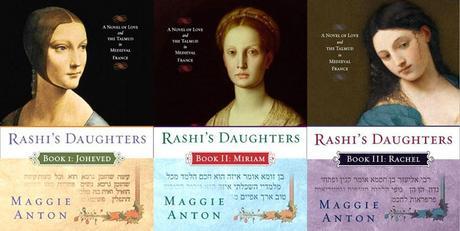 The first published woman author in America was Anne Bradstreet, who published her book of poems The Tenth Muse Lately Sprung Up in America in 1650. Ever since, millions of words have been penned by women authors. Recently, historical Jewish women's fiction has become popular, with dozens of writers researching and recording the lives of Jewish women of the past. Star of Davida had the honor of interviewing Maggie Anton, the author of the Rashi's Daughters series, a trilogy which chronicles the lives of Rashi's three daughters: Joheved, Miriam, and Rachel.
The first published woman author in America was Anne Bradstreet, who published her book of poems The Tenth Muse Lately Sprung Up in America in 1650. Ever since, millions of words have been penned by women authors. Recently, historical Jewish women's fiction has become popular, with dozens of writers researching and recording the lives of Jewish women of the past. Star of Davida had the honor of interviewing Maggie Anton, the author of the Rashi's Daughters series, a trilogy which chronicles the lives of Rashi's three daughters: Joheved, Miriam, and Rachel.I understand that you were achemist, which is unusual for a woman of your generation. What inspired you topursue a career in the sciences?I was always very good in scienceand math in school, as well as enjoying the subjects. And it seemed that therewere many more career opportunities for women there than in other fields.
I was also always intrigued bythe fact that Rashi only had daughters. Do you know why they touched you somuch to write a whole book series about them?I started studying Talmud in awomen’s Talmud class in early 1990s. Our teacher pointed out that Rashi had nosons, and that his daughters were reputed to be learned and wear tefillin.I was intrigued enough to do some research to see if these legends were true,and what I found inspired me to write about them.
It’s clear from reading thebook that you’re very well-versed in both Torah and Talmud. Was this somethingyou were raised with, or are you self-taught?I was raised in a secularhousehold, and didn’t start my Jewish studies until I married. I’ve taken manyTorah and Talmud classes with some excellent scholars, but more recently I’vestudied Talmud individually with a hevruta (study-partner).
Based on your books, it seemsthat sex was much more openly discussed in the eleventh century. Is that true?Sex is certainly openly discussedin the Talmud, and the 11th-12th centuries appears to have been pretty open andtolerant about these matters.
Do you know why Lilith, thereal first woman who was created at the same time as Adam, became such athreatening figure for Jewish women in the Middle Ages?I think it’s more a matter ofLilith threatening men, although a demon who attacked newborns and theirmothers is common in many medieval and ancient cultures.
In Miriam, many malecharacters are depicted with homosexual leanings. Was “playing the game” reallythat common in Rashi’s era? What about among women?Homosexuality was at least ascommon in Rashi's time as today, however the desire was considered normalrather than perverse. People discussed the subject much more openly then.Typical of ancient and medieval times, men didn’t seem to care or know whatwomen did.
I had no idea that mohelotexisted before the 21st century. How common was it in the 11th century? Are anymohelot from that era known by name?None are known to use by name. Itprobably wasn’t too common, but the fact that rabbis complained about it showsthat the practice existed.
In Rachel, the sistersco-write Rashi’s commentary on Tractate Nedarim. Do you think the argumentthat this is true holds water?We know that Rashi didn’t write “his”commentary on Nedarim, yet strangely the true author's name has beenlost. There are scholars who believe his daughters wrote it, which is why theauthor remained nameless. After a careful study of the text, it does seem tohave a feminine perspective.Do you think Rashi would behappy to see how women’s education in Talmud and Judaism has proliferated? Absolutely.
Do you have any other books inthe works?My next series, Rav Hisda’sDaughter, is set in 3rd-4th century Babylonia,in the household of a Jewish sage as the Talmud is being created. At the sametime Rome, fast becoming a Christian empire,battles Zoroastrian Persiafor world dominance. Against this backdrop, my heroine embarks on the tortuouspath to become an enchantress in the society where the word ‘magic’ originated.The first volume should be out in August 2012.
I read the account of theFirst Crusade in Rachel soon after Leiby Kletzky’s z”l murder, which wasnot such great timing. How do you think the Jewish community has managed tosurvive, despite all of the horrific acts that have occurred in our history?Being dispersed throughout theworld, Jews could never be destroyed in its entirety. With so much animositydirected against us, we were not able to assimilate easily and tended to staywithin our own communities.

